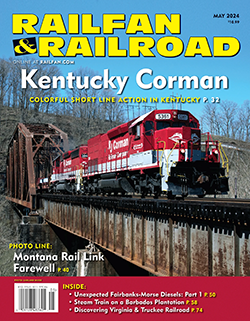You will find a special “Photo Line” in the May issue bidding farewell to regional railroad Montana Rail Link. In case you didn’t already know, MRL was a line that served its namesake state (and a little bit of Idaho). Founded in 1987, MRL was long known for its classic second-generation diesel locomotives painted in an attractive blue and a territory full of beautiful scenery, as well as a friendly, scrappy attitude among its crews. After 35 years of successful growth, everything suddenly changed. In January 2022, BNSF Railway announced its intention to pay MRL to terminate its lease of its lines owned by BNSF, and in turn, to effectively absorb the lines back into the BNSF system. This process was completed on January 1 of this year.
The two-year-long process of winding down MRL gave many railfans the time to take one last look, cameras in hand. In many cases, it was also a first look. It seems sometimes that the imminent end for a piece of equipment, a line, or a company results in an increased awareness among railfans that those things even existed, and an even more increased urgency to go see them. Sometimes, it is as if we cannot really appreciate what we have until it is on the cusp of disappearing forever.
One way we might respond better to this would be to predict what things are most endangered, and then go seek them out now, to make the most of our time with them. I’ve written about this in these pages before, suggesting, for example, that we should go see (and photograph) places where code-line poles, searchlight signals, or first-generation diesels still exist. If I were to update that list for today, I’d add second-generation diesels such as SD40-2s or even GP-38s, all of which were once common, but are slowly disappearing from the rails as they approach six decades of service.
Making an updated list might be an interesting topic for this column in the future, but I want to make a slightly different suggestion for the moment. Once upon a time, everything that we might soon lose, or that we are in the process of losing, was simply the everyday. Amfleet passenger cars are on the way out, being replaced by modern equipment. But 20 years ago, we thought them boring and without merit. The 50-foot boxcar was once common as dirt, merely part of the visual background of the railroad landscape, but if you pay close attention, you’ll see there are fewer and fewer of them. End-cab switchers were never glorious when, day in and day out, they shuffled through industrial parks and down yard leads, but they seem very charming and full of character now that they are nearly gone.
I’m not sure the best response to the constant change of the railroad landscape is to become a permanent mourner, crabbing about what is no longer — and I say that despite having some strong feelings over some of my favorite things since lost. I’m also not sure that looking out on the horizon for the next big loss is the best approach, either — it verges on wanting those losses to happen as a way to justify our obsessions. Rather, I think the lesson we should take from our retrospective MRL gallery, or of any loss, is to think more about what we have now.
Don’t wait for the cancellation notice, merger announcement, or scrapping bid to act. Get out, ride every train you can, visit every line you want to see, and take nothing for granted. Whether those things disappear tomorrow or last for many years to come, you will not regret your choice.
Alexander Benjamin Craghead is a transportation historian, photographer, artist, and author.
This article appeared in the May 2024 issue of Railfan & Railroad. Subscribe Today!
The post No Regrets? appeared first on Railfan & Railroad Magazine.

